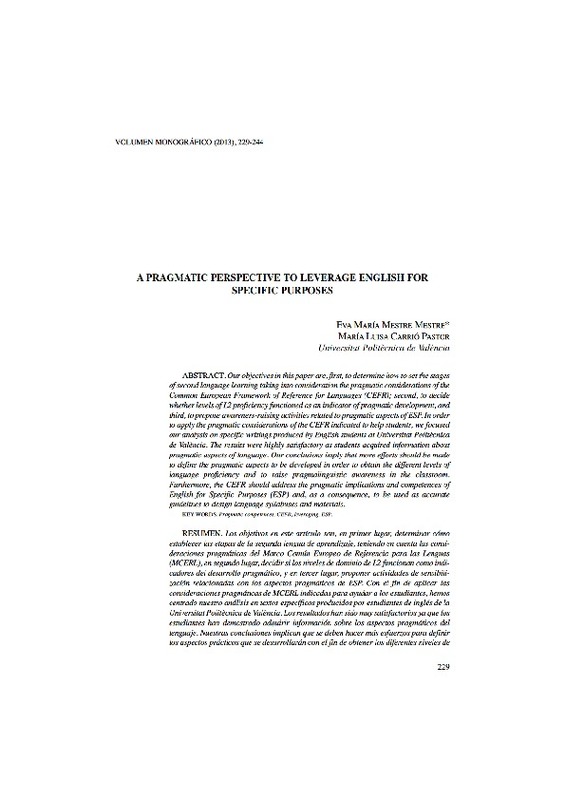|
Resumen:
|
[EN] The Common European Framework of Reference for Languages (CEFR) is aimed at helping levelling and assessing throughout Europe, by identifying common levels of aptitude. It describes language proficiency based on a set ...[+]
[EN] The Common European Framework of Reference for Languages (CEFR) is aimed at helping levelling and assessing throughout Europe, by identifying common levels of aptitude. It describes language proficiency based on a set of abilities and skills that the speaker needs to master. The communicative approach used for the expression of these abilities and skills is threefold: linguistic, sociolinguistic and pragmatic. Our objectives in this paper are, first, to determine how to set the stages of second language learning taking into consideration the pragmatic considerations of CEFR; second, to decide whether levels of L2 proficiency functioned as an indicator of pragmatic development, and third, to propose awareness-raising activities related to pragmatic aspects of ESP. In order to apply the pragmatic considerations of CEFR indicated to help students, we focused our analysis on specific writings produced by English students at Universitat Politècnica de València. Among possible writings proposed as suitable by the CEFR to leverage students, summaries and letters were compiled as texts for the corpus analysis. We selected thirty students with B1 and B2 levels of proficiency (following CEFR descriptors) enrolled in our engineering English classes at the university. They were enrolled in class activities to raise their pragmatic awareness and were asked to write specific summaries and formal letters. The results were highly satisfactory as students acquired information about pragmatic aspects of language. Our conclusions imply that more efforts should be made to define the pragmatic aspects to be developed in order to obtain the different levels of language proficiency and to raise pragmalinguistic awareness in the classroom. Furthermore, the CEFR should address the pragmatic implications and competences of English for Specific Purposes (ESP) and, as a consequence, to be used as accurate guidelines to design language syllabuses and materials.
[-]
[ES] Los objetivos en este artículo son, en primer lugar, determinar cómo
establecer las etapas de la segunda lengua de aprendizaje, teniendo en cuenta las consideraciones
pragmáticas del Marco Común Europeo de Referencia ...[+]
[ES] Los objetivos en este artículo son, en primer lugar, determinar cómo
establecer las etapas de la segunda lengua de aprendizaje, teniendo en cuenta las consideraciones
pragmáticas del Marco Común Europeo de Referencia para las Lenguas
(MCERL), en segundo lugar, decidir si los niveles de dominio de L2 funcionan como indicadores
del desarrollo pragmático, y en tercer lugar, proponer actividades de sensibilización
relacionadas con los aspectos pragmáticos de ESP. Con el fin de aplicar las
consideraciones pragmáticas de MCERL indicadas para ayudar a los estudiantes, hemos
centrado nuestro análisis en textos específicos producidos por estudiantes de inglés de la
Universitat Politècnica de València. Los resultados han sido muy satisfactorios ya que los
estudiantes han demostrado adquirir información sobre los aspectos pragmáticos del
lenguaje. Nuestras conclusiones implican que se deben hacer más esfuerzos para definir
los aspectos prácticos que se desarrollarán con el fin de obtener los diferentes niveles de competencia lingüística y potenciar los aspectos pragmalingüísticos en el aula. Además,
el Marco Europeo de Referencia debe abordar las implicaciones pragmáticas y competencias
de inglés para fines específicos (IFE) y, en consecuencia, han de usarse como
directrices precisas para el diseño de planes de estudio y materiales lingüísticos.
[-]
|







